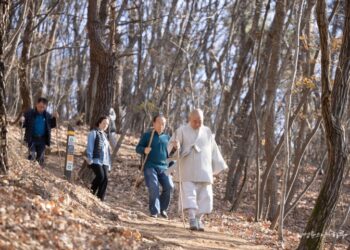February 24, 2025 – Day 8 of the 100-Day Dharma Talk, Open Dharma Assembly Lecture 4
Hello everyone. Today is the 8th day of Venerable Pomnyun Sunim’s 100-Day Dharma Talk. This week features opening lectures before the main course begins. In the morning, an Open Dharma Assembly is held on the topic of “1000-Day Practice Method,” and in the evening, another Open Dharma Assembly focuses on the “Soshimgyeong(小心經)”.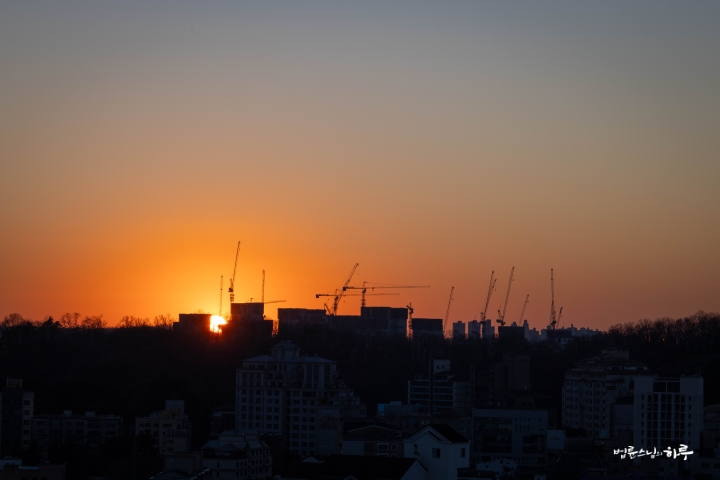
After completing his morning practice and meditation, Sunim headed to the Jungto Social and Cultural Center.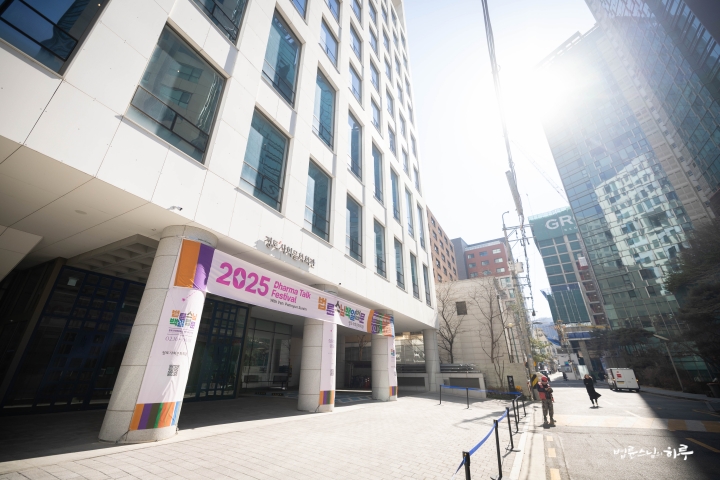
On the third floor in the Dharma hall, after diligently performing the 9 AM morning service, preparations were being made for the Open Dharma Assembly. At 10:15 AM, the assembly began with the recitation of the Three Refuges and the Heart Sutra.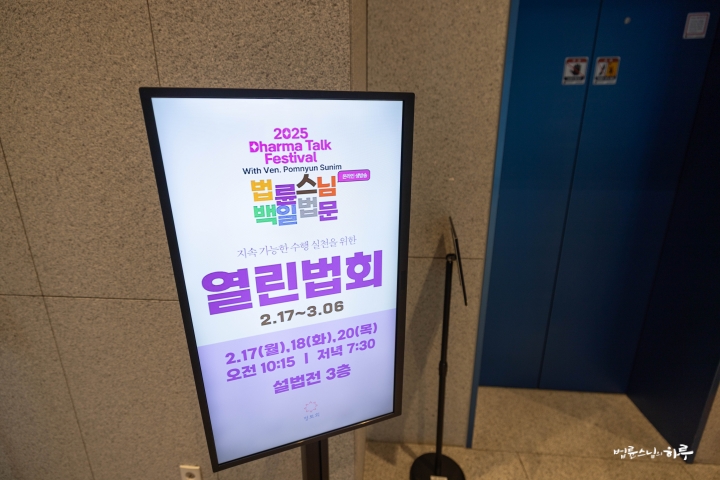
With about 150 people in attendance, they requested Dharma teachings from Sunim with three bows. Starting today, the Open Dharma Assembly focuses on the “1000-Day Practice Method,” which Jungto Society members practice for one hour every morning. In this first session, Sunim explained in detail the significance of taking the Three Refuges, which is the first step in the 1000-Day Practice.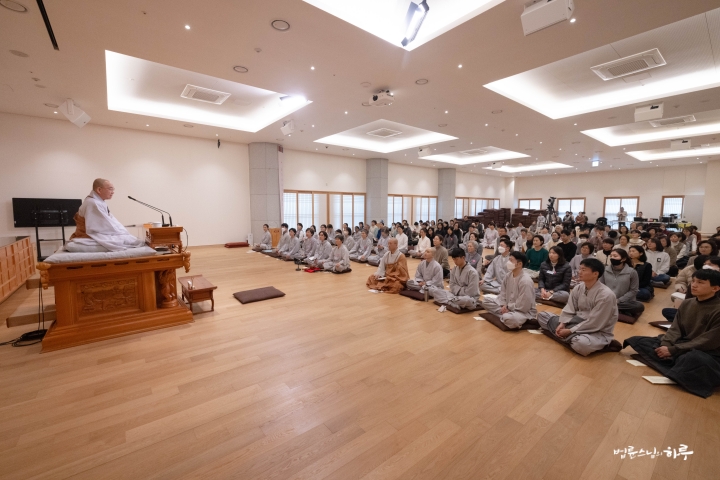
“Practice means being awake here and now. However, when being awake becomes repetitive, it can become habitual, and you actually end up not being truly awake. There is a fundamental difference between being awake and thinking that you should be awake. Thinking ‘I should be awake’ is an act of will, not mindfulness. Similarly, during meditation, being aware of your breath is completely different from thinking ‘I should be aware of my breath.’ Yet we can easily fall into this misconception when practicing. When practice becomes familiar and habitual, it may be beneficial in terms of approaching it with a comfortable mind, but it actually becomes an obstacle to the original goal of practice, which is ‘being awake’. Therefore, you should always practice as if it were your first time.
When you first practice, you may feel a bit tense, but your awareness is very clear. However, with repetition, although there is familiarity, you lose that awareness. That’s why sages throughout history have emphasized the importance of the initial mind when you first set out on the path. They said, ‘If you can maintain the mind you had when you first set out, that is equivalent to achieving enlightenment’. That’s how important they considered the initial mind.
So starting today, we will revisit how the ‘1000-Day Practice Method’ in Jungto Society is structured and what its meaning is. I’m not teaching you something you don’t know, but rather examining what you already know. The purpose of this lecture is to encourage you to be aware of the meaning when you practice every morning.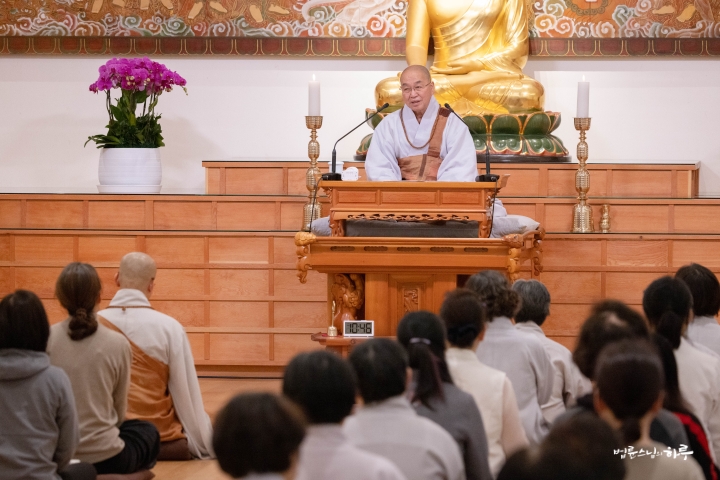
Three Things a Practitioner Should First Commit To
Whatever practitioners do, they should first take refuge in the Three Jewels—the Buddha, the Dharma, and the Sangha—before doing anything else. First, they should take refuge in the Buddha.
This is about taking refuge in the Buddha. The Buddha is an enlightened and noble being, so it is right to praise and revere him. However, the core meaning is making a vow to become like the Buddha. For me, taking refuge in the Buddha means becoming a person who is free from ignorance, free from suffering, and truly liberated. So this sentence essentially means “I vow to achieve liberation and nirvana and become a Buddha myself.”
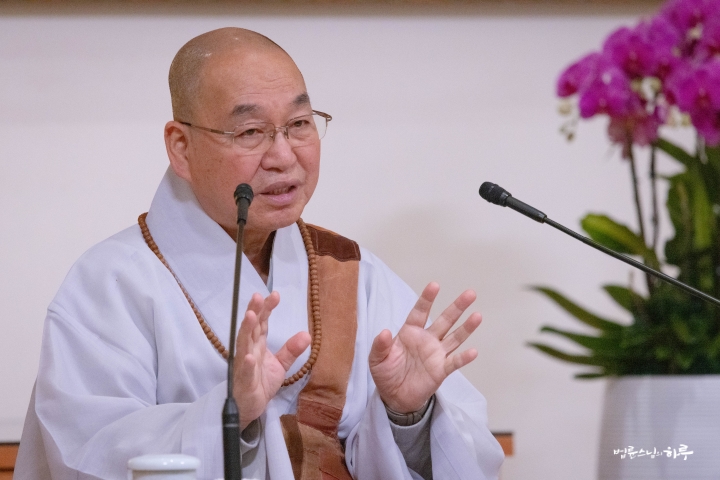
This is about taking refuge in the Buddha’s teachings (Dharma). It means that the Buddha’s teachings contain everything we need. This is because his teachings include everything that can free us from afflictions. The core of the Buddha’s teaching is that I create causes and I receive their effects. This is the principle of cause and effect that governs the world. When we say someone is “ignorant”, we mean they don’t understand this principle of cause and effect. Conversely, being clear about the principle of cause and effect is called “wisdom”.
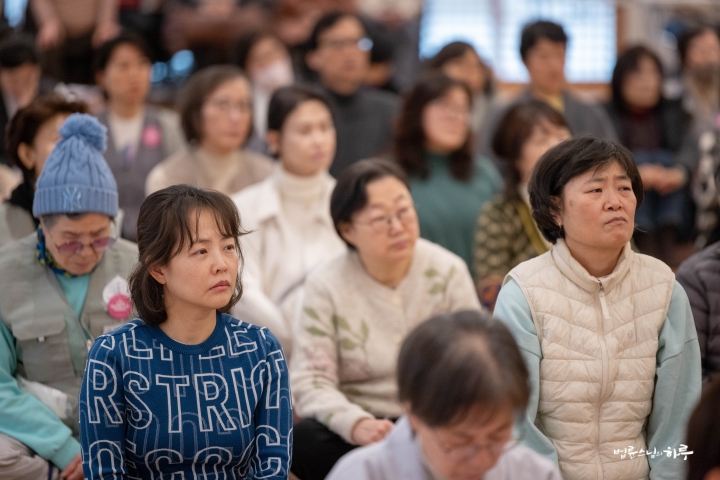
Everything Proceeds From Me and Returns to Me—Why Is This So?
Understanding that everything proceeds from me and returns to me means understanding cause and effect. Everything that happens in this world has a cause, even if we don’t know what it is. We simply say “cause,” but when examined closely, it consists of a direct “cause” and surrounding “conditions.” When we say that planting a seed in a field makes it sprout, it seems like the seed is the only cause, but there must also be suitable soil for the seed to germinate. There must be appropriate humidity and temperature, and fertilizer as well. Only then can the seed sprout and grow. Here, the seed is called the “cause” and the condition of the field is called the “condition”. The sprouting and growing is called the “effect”, and the resulting joy or suffering is called the “result”. That’s why we express it as “cause, condition, effect, and result”. If we remove the “result” of joy or suffering and explain it only scientifically, we express it as “cause, condition, and effect” or more simply as “cause and effect.”
Practicing diligently means “willingly accepting what has already happened” and also “refraining from creating karma through body, speech, and mind.” Refraining means keeping precepts purely. Even if you get angry and want to hit someone with your fist, you must refrain. Even when you’re angry and want to curse, you must refrain. Even when you want to steal something, you must refrain. Even when sexual desire arises, you must refrain. If you don’t refrain, the consequences will come back to you tenfold or twentyfold.
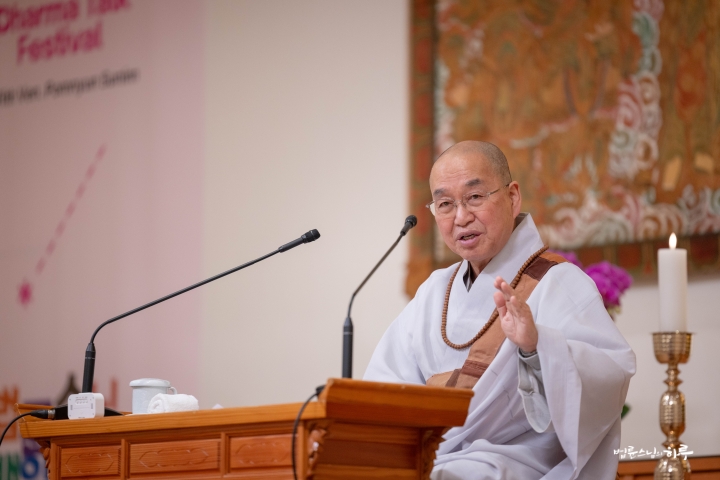
With a little observation, we can see that the law of cause and effect is a scientific truth. It’s exactly like Newton’s law. For an object to move, a force must be applied. The object moves in proportion to the force applied, but other conditions also affect the outcome. Factors such as friction acting on the object and the object’s current state determine the result. When an object moves, it means that although invisible, a force has been applied somewhere, and when I want to move an object, I must apply force. Therefore, the law of cause and effect cannot be avoided. When an object doesn’t move despite applying force, it may be because the friction acting on the object prevents movement with just the applied force.
When we understand this teaching, we stop doing things that harm ourselves, willingly accept the consequences of what we’ve already done, and gladly do beneficial things even if they’re a bit difficult. This is what it means to practice diligently.
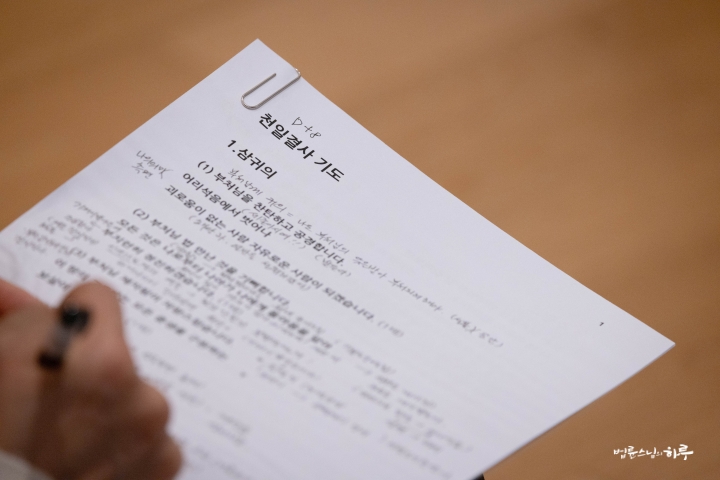
This is about taking refuge in those who follow the Buddha’s teachings. It means I am proud to be a member of the Sangha. However, it doesn’t end with just being proud of that membership. After attaining enlightenment and nirvana, the Buddha didn’t simply remain comfortable and still. If comfort were the only goal, nothing would be better than staying still. Instead, the Buddha spent his life spreading the Dharma. When trying to enlighten foolish beings who are wrapped up in their own thoughts, one encounters many difficult situations. However, as disciples of the Buddha, we too must willingly embark on the path of spreading the Dharma. We must widely share this teaching so that many people can understand it and be freed from suffering.
Taking refuge in the ‘Buddha’ means clearly defining what I aim to become. Taking refuge in the ‘Dharma’ means making efforts according to the Buddha’s teachings to progress toward that goal. Taking refuge in the ‘Sangha’ means spreading this wonderful teaching to people in the world who haven’t yet encountered it. This is the ‘Triple Refuge’—first taking refuge in the Three Jewels, then establishing the vow to spread the Dharma.”
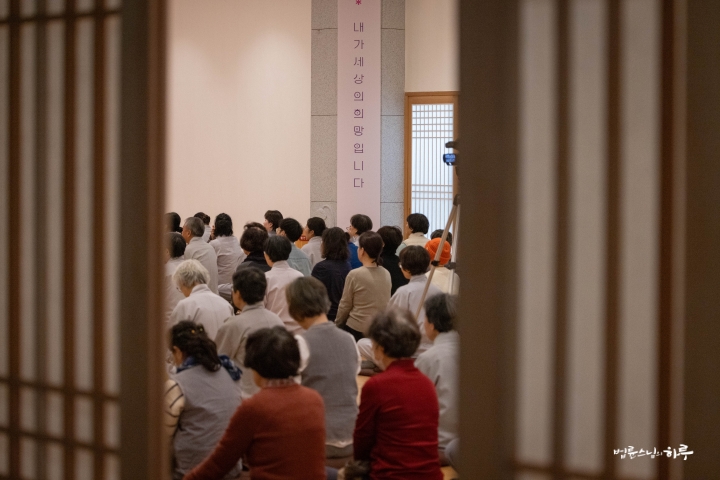
After finishing his Dharma talk and stepping down from the Dharma seat, Sunim joined the participants as they gathered in groups to share their thoughts. Following the Four Great Vows, the Open Dharma Assembly concluded at 11:30 AM.
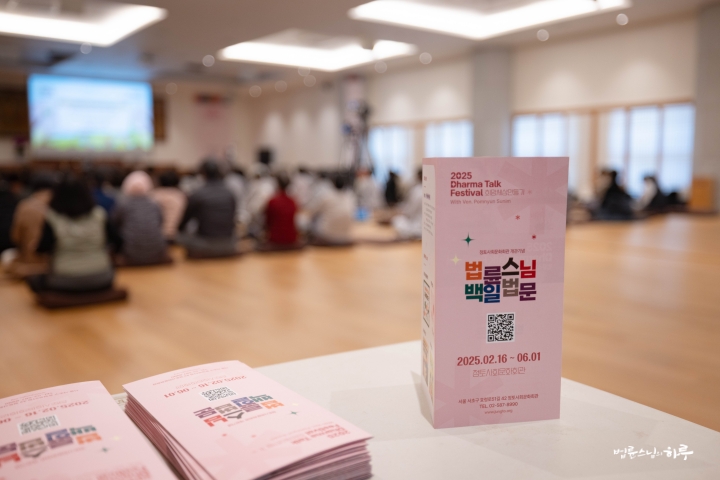
After having lunch with the participants in the dining hall on the first basement level, Sunim quickly moved to The Peace Foundation meeting room. At noon, he participated online in the LA Jungto Society board meeting. The meeting included reviewing the 2024 business report and financial statements, as well as deliberating and approving the 2025 business plan and budget. In the afternoon, Sunim handled various administrative tasks indoors.

As the sun set, at 7:30 PM, Sunim conducted another Open Dharma Assembly for evening session members. About 90 people who had come directly after work filled the third-floor Dharma hall. During this evening assembly, Sunim gave a Dharma talk on the “Soshimgyeong,” the verse recited during Barugongyang (formal Buddhist monastic meal) that the residential community members of Jungto Society chant every morning.
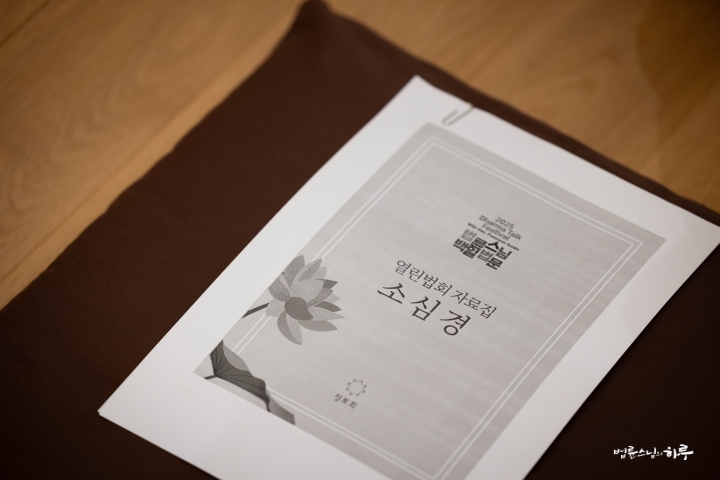
Today was the first session explaining the meaning of Barugongyang and the practice spirit embedded within it. Before explaining the Soshimgyeong verse recited during Barugongyang, Sunim emphasized that Barugongyang is not simply an act of consuming food but is directly connected to a practitioner’s attitude and way of life. He explained that reducing greed and living frugally through Barugongyang is the path of a practitioner, and that this is not merely a mealtime ritual but a practical method of practice applicable to one’s entire life. He then explained the meaning of each phrase of the Soshimgyeong.
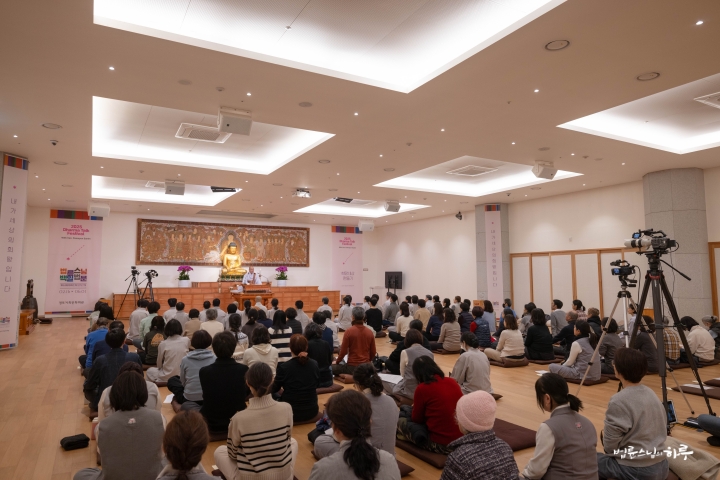
“The spirit embodied in Barugongyang can be summarized as ‘live frugally’ and ‘minimize your level of consumption.’ During the Buddha’s time, monastic practitioners received food as alms, wore discarded clothing, and slept under trees. This lifestyle changed later when Buddhism became institutionalized and temples were built in cities, but in the early days, most forest-dwelling practitioners lived this way. In India particularly, the culture of begging for alms existed even before Buddhism emerged. The practice of monastic life was something that had existed in traditional Indian society, which the Buddha simply followed. Therefore, in Thailand and other tropical regions with cultures similar to India’s, it wasn’t particularly difficult for practitioners to maintain this lifestyle.
Historical Background of Barugongyang
However, as Buddhism spread to China, the climate conditions for practitioners changed significantly. China has very cold weather. Additionally, Chinese culture viewed begging from others very negatively. So while practitioners in India could beg for alms, this became impossible in China. As Buddhism became institutionalized, large temples were built with donations from kings and wealthy patrons. However, around the 6th century in China, a movement arose opposing this trend and advocating a return to the Buddha’s original teachings. This was Seon Buddhism. When practitioners lived together in community, there were no separate people designated for cooking. There was no salary for those who prepared meals, no separate builders, no separate statue makers, and no separate people bringing rice. Therefore, monks living in temples had to farm, do carpentry, and handle all other tasks themselves. Among the monks, those skilled in carpentry, painting, sculpture, farming, or cooking divided these duties while continuing their practice. When eating, they recited verses to instill the mindset of living frugally as if begging for alms. This is the Soshimgyeong. This was a way to guard against the danger of slipping into secular life while cooking, building, and farming. Even though they prepared food at the temple, they maintained the form of begging for alms. Did Seon Buddhism initiate this lifestyle? Not exactly. Such practices existed in the Vinaya school and others before Seon Buddhism. However, the Barugongyang as we practice it today was largely standardized within Seon Buddhism.

What Should Be Our Mindset During Barugongyang (Formal Buddhist Meal)?
The Soshimgyeong (小心經) outlines the mindset we should have during Barugongyang. Although it has “gyeong” (sutra) in its name, making it sound like the Buddha’s direct words, that’s not entirely the case. While it does contain some of the Buddha’s teachings, it’s best understood as a collection of thoughts we should keep in mind while eating.
Practitioners should eat minimally. Since food embodies the hard work of many people, simply consuming it creates a debt. Therefore, we must examine whether we deserve this food today. If we feel unworthy, we should practice more diligently, work harder, or make corresponding efforts. This constant self-examination is the core message of the Soshimgyeong.
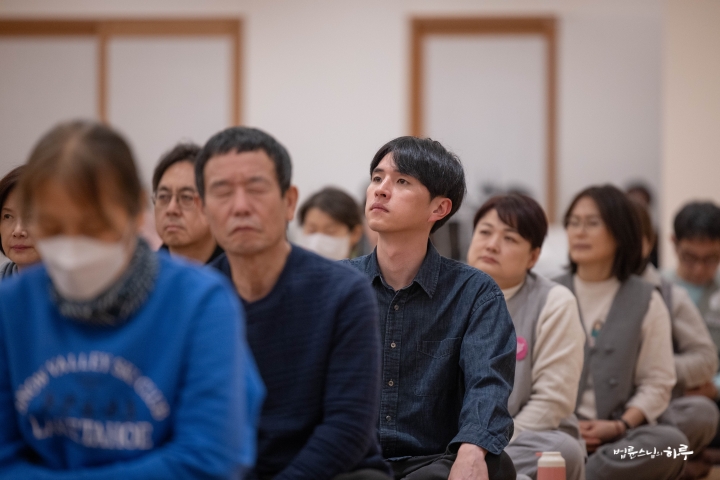
We should consider the efforts of all those who worked to bring this food before us and examine whether we deserve to eat it. After eating, we must clearly commit to “attaining enlightenment through diligent practice and dedicating it to all sentient beings.” The text also reminds us to think of hungry people while we eat our fill, encouraging us to reduce our portion slightly to share with those who are hungry.
In the term Barugongyang (鉢盂供養), “Baru” comes from the Indian word “patdana,” meaning “appropriate amount.” The Chinese character “bal” (鉢) translates to “yeungyang” (應量), meaning “appropriate quantity.” “U” (盂) is the Chinese word for a rice bowl. Together, “Baru” means “a bowl that holds an appropriate amount.” It’s also sometimes translated as “yeungyangi” (應量器).
Why “appropriate amount” rather than “sufficient amount”? For practitioners, the appropriate amount is the minimum needed for survival. This is what’s suitable for a practitioner. We shouldn’t have leftovers to waste, nor should we eat so much that we gain weight. Eating too little could cause illness or emaciation, making continued practice impossible. Since practice requires a body, the appropriate amount is the minimum food needed to maintain this body. The bowl that holds this appropriate amount is the Baru.
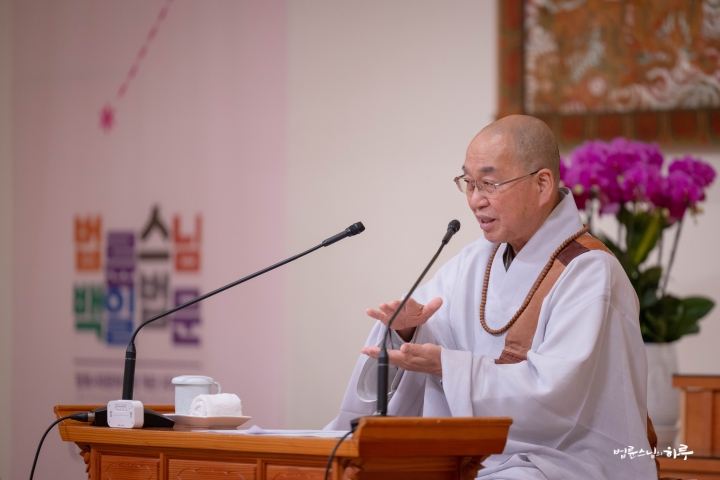
Words to Engrave in Your Heart When Holding and Opening Your Bowl
The first verse recited during Barugongyang (formal Buddhist monastic meal) is the Habalgye (下鉢偈). This is the verse recited while taking the bowl from the shelf with both hands.
The meaning is: “As I hold this bowl, I vow that all beings will become vessels of the Dharma and receive offerings from humans and devas.” For beings to become vessels of the Dharma means they attain enlightenment. Those who are worthy of receiving offerings from humans and devas are called “Eunggong,” and such a person is an Arhat. As I hold this bowl, I am making a vow to help all beings attain enlightenment. Here, “beings” refers both to myself and to all sentient beings. So this verse also means that I will practice diligently to attain enlightenment and become an Arhat worthy of receiving offerings from humans and devas. It reminds us that the purpose of eating is to attain enlightenment.
Now, holding the bowl, you sit in your place. When everyone is seated, the wooden clapper is struck three times, and then once more, signaling the recitation of the Hoebalgye (回鉢偈). “Hoebal” means to reflect on the origins of the bowl offering ritual.
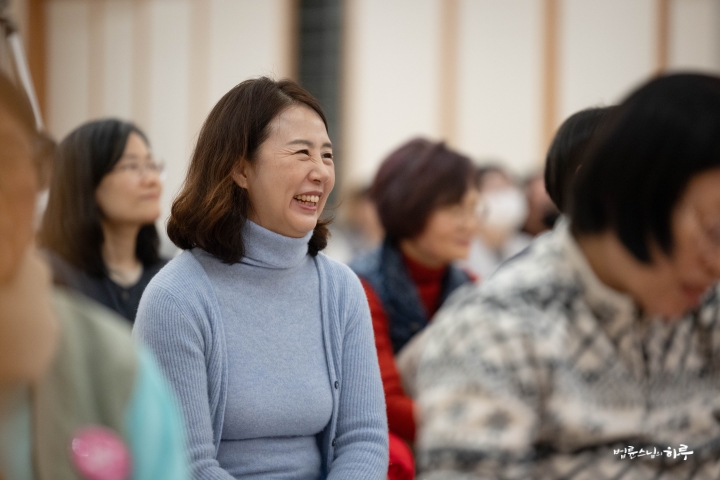
Barugongyang (formal Buddhist monastic meal) originated from the Buddha. So we reflect on the Buddha. When the Buddha was about to enter nirvana, Venerable Ananda asked, “We have always thought of the Buddha, but who should we think of when you are gone?” The Buddha replied, “Think of the four holy sites.” That’s why during Barugongyang, we first think of the four holy sites. The four holy sites refer to where the Buddha was born, where he attained enlightenment, where he first gave a sermon, and where he entered nirvana.
Next, we unfold our bowls. The verse recited while unfolding the bowl is called Jeonbalgye (展鉢偈).
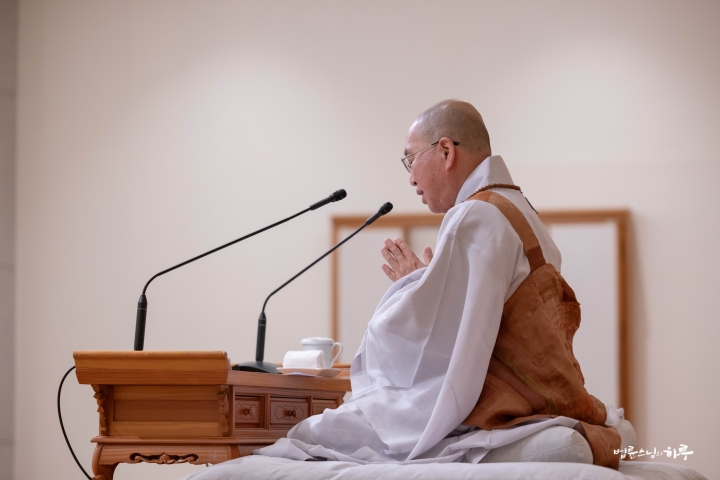
This means: “Now that I have unfolded this bowl given by the Buddha, I wish that all beings together may attain the purity of the three wheels.” The three wheels refer to the giver, the receiver, and the gift itself. “Purity” means being clean without any flaws. The giver should give with a pure mind, the receiver should receive with a pure mind, and the gift should be appropriate to the need—this is when the three wheels are pure. If the giver provides something like a bribe, it is not pure. If the receiver accepts something they don’t need, it is not pure. If the gift doesn’t specifically help with practice, it is also not pure. For example, food for the hungry, clothing for those without clothes, or medicine for the sick—these are appropriate gifts. Offering things that aren’t necessary or unrelated to practice is not pure. The Jeonbalgye is about unfolding our bowls while vowing that all three aspects will be pure. I will continue with the next passage in tomorrow’s lecture.”
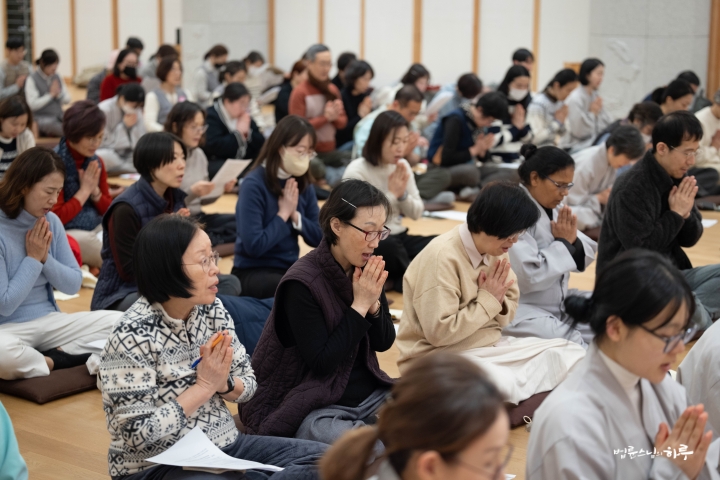
As the Dharma talk concluded, the participants gathered in groups to share their thoughts, while Sunim left the Dharma hall and headed to the Jungto Center.
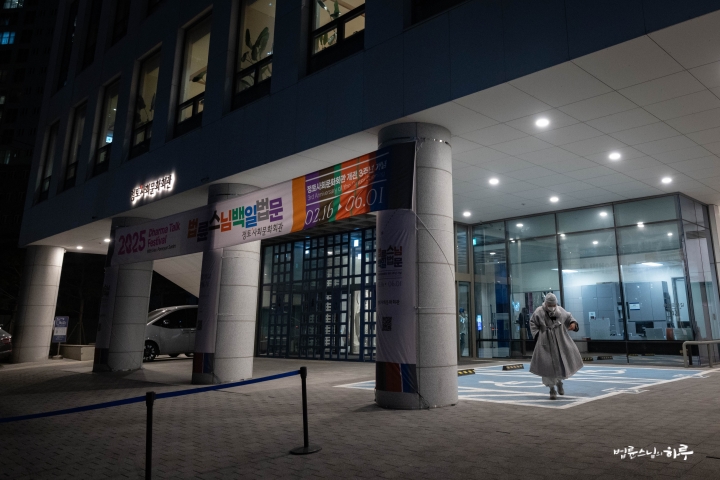
Tomorrow will be the ninth day of the 100-Day Dharma Talk. In the morning, there will be an Open Dharma Assembly on the topic of “1000-Day Practice Methods,” followed by Sunim’s online attendance at the JTS Philippines and Jungto Society Philippines board meetings in the afternoon. In the evening, another Open Dharma Assembly will be held on the topic of the “Soshimgyeong(小心經)”.




